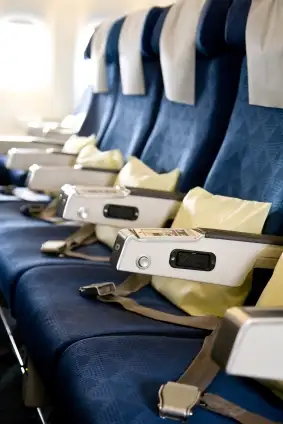
Nickel-and-dimed to distraction, and crammed into crusher seats on full-to-bursting flights, travelers today naturally wonder if there isn’t a better way.
A better balance of comfort and value when it comes to seating. A fairer, more transparent way to price tickets. More customer-friendly reservations and ticketing policies. Better service throughout the trip.
In short, a better way to run an airline.
TEAGUE, a Seattle-based design firm that counts the Polaroid Land Camera (1948), the Microsoft Xbox steering wheel (2000), and the Boeing 787 Dreamliner (2011) among its successful engagements, took up the challenge.
The biggest enemy of today’s airlines isn’t cutthroat competition or complex regulatory processes — it’s the status quo. Conventional thinking about the way we structure and operate our businesses leaves us vulnerable to the innovations of others. This is how Uber upended the taxicab industry, and how Airbnb is challenging hoteliers. Yes, barriers to entry in the airline industry are high. But the industry’s current trajectory of taking more — and giving less — to increasingly dissatisfied passengers is a perfect set-up for disruptive innovations.
But what if we could anticipate those disruptive innovations? This question inspired TEAGUE to design an airline of the future — a startup airline unencumbered by the status quo.
The key features of TEAGUE’s reimagined airline:
- The airline would be called Poppi, a name that’s equal parts peppy and paternal.
- Tiny overhead bins, just for coats and shoulder bags.
- All other bags would be fitted with RFID tags and checked.
- Middle seats receive promotional items from marketing partners, to compensate for the discomfort.
- A “re-imagined” gate experience, with real-time information updates to speed boarding and reduce stress.
- Creative redesign of the traditional three-class seating scheme. Example: “cinema class” featuring big-screen movies.
In fleshing out its fantasy of a better airline, TEAGUE’s stated goal was anything but modest: to “illuminate new ways forward for airlines operating today.” That turns out to be a higher hurdle than they’d perhaps anticipated.
Sure, requiring that all bags be checked, to speed boarding, and tagging bags with RFID transmitters, to ensure they’re not lost, seems like an improvement over current industry practices.
But of all TEAGUE’s recommendations, that’s the most specific and the most actionable. And it’s hardly a revolutionary or disruptive change to the airlines’ business model.
What TEAGUE’s sincere but ultimately underwhelming effort points up, discouragingly, is the difficulty of significantly improving an industry that consistently falls short of consumers’ expectations.
It turns out that reinventing the airline experience is easier said than done.
Reader Reality Check
How would you improve the airline experience?
This article originally appeared on FrequentFlier.com.
We hand-pick everything we recommend and select items through testing and reviews. Some products are sent to us free of charge with no incentive to offer a favorable review. We offer our unbiased opinions and do not accept compensation to review products. All items are in stock and prices are accurate at the time of publication. If you buy something through our links, we may earn a commission.
Related
Top Fares From
Today's Top Travel Deals
Brought to you by ShermansTravel
Porto to Lisbon: 7-Nt, Small-Group Portugal...
Indus Travels
 vacation
$1899+
vacation
$1899+
Greenland: Luxe, All-Incl. 11-Nt Exploration Small-Ship...
Swan Hellenic



Ohio: Daily Car Rentals from Cincinnati
85OFF.com





